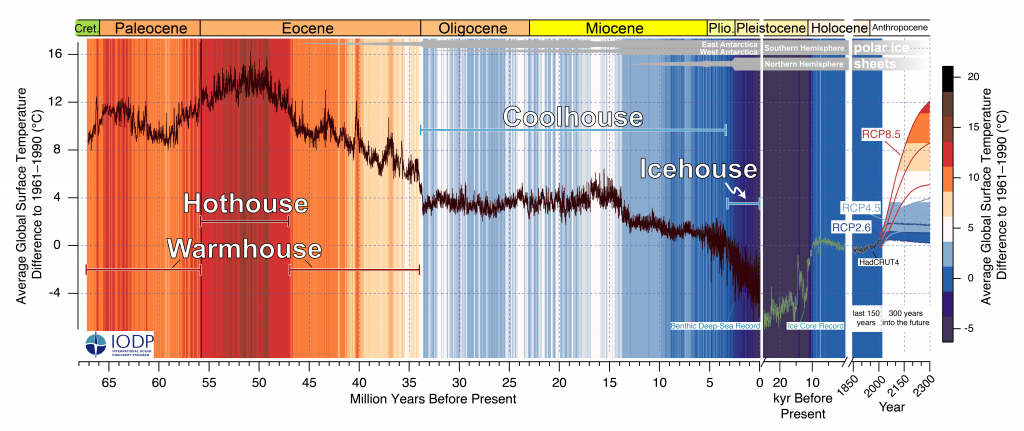66 million years of climate history unravelled
A team of climate scientists reconstructed Earth’s climate with the highest resolution to date. The international team, among them NESSC-researcher Lucas Lourens (Utrecht University), compiled and analyzed a comprehensive dataset obtained from sediment cores from the ocean floor. The new reconstruction goes back 66 million years back in the past. It shows that the earth’s climate has experienced four distinct climate modes: from extremely warm (hothouse earth) to extremely cold (icehouse earth). The study has appeared in the prestigious professional journal Science.
“Our goal was to create a new reference of past climate over the last 66 million years, which not only incorporates the highest-resolution data but is also more accurately dated,” explains climate scientist Thomas Westerhold (MARUM, Bremen). “We now know more accurately when it was warmer or colder on the planet and we also have a better understanding of the underlying dynamics.”
The view into the past also serves as a glimpse into the future. We can learn something about the staggeringly rapid anthropogenic changes of our present century from the slow natural climate fluctuations occurring over millions of years. The climatic changes of the past 66 million years can be studied like a colorful barcode.

Drilling expeditions
Layers of sediment on the ocean floor form the building blocks of the new climate reconstruction. The ocean floor has been sampled throughout the world by the scientific drill ship JOIDES Resolutionl for more than five decades through internationally coordinated expeditions. By studying these sediments and the microfossils within, scientists are able to reconstruct and analyze global climate changes into the distant past. They examine the evidence preserved in oxygen and carbon isotopes, which provides information about the past deep-sea temperatures, global ice volumes and the carbon cycle. These clues are stored in the shells of microorganisms that once lived on the sea floor. They represent an archive of past climate conditions that researchers use to draw comparisons between the past, present and future.
“I was a scientific participant in one of the key expeditions, now 18 years ago,” says NESSC-researcher Lucas Lourens. “The data coverage older than 34 million years was generally poor. Over the past two decades, scientific drilling programs have targeted their drilling into older geological strata. We have a more complete sediment archive now, and are able to reconstruct global climate in much more detail than ever before.”

Hothouse earth
The new climate reference curve, called CENOGRID (CENOzoic Global Reference benthic foraminifer carbon and oxygen Isotope Dataset), is a reconstruction of the Earth’s climate since the last great extinction 66 million years ago, which introduced a new Era, the Cenozoic. “It is a tremendous joint effort by many colleagues internationally to recover the sample material, analyze it and compile it into an integrated curve,” underlines Westerhold.
The data and age models of CENOGRID have been radically improved to understand what climate conditions existed in the past, what processes lay behind them, and how they proceeded. The researchers recognize four predominant climatic modes in the past 66 million year: hothouse, warmhouse, coolhouse and icehouse. The abrupt shifts between these different climate modes might be caused by tipping points in the climate system, which is the subject of further investigations.
The CENOGRID reconstruction can serve as a basis for researchers worldwide to accurately correlate their data within the context of climate history. With more data, it is now possible to further refine the picture of the climatic past and to identify regional intricacies. The authors emphasize that this is fundamental for testing the reliability of climate models for the future.
Article:
An astronomically dated record of Earth’s climate and its predictability over the last 66 Million Years
Science, 2020
Thomas Westerhold, Norbert Marwan, Anna Joy Drury, Diederik Liebrand, Claudia Agnini, Eleni Anagnostou, James S. K. Barnet, Steven M. Bohaty, David De Vleeschouwer, Fabio Florindo, Thomas Frederichs, David A. Hodell, Ann E. Holbourn, Dick Kroon, Vittoria Lauretano, Kate Littler, Lucas J. Lourens, Mitchell Lyle, Heiko Pälike, Ursula Röhl, Jun Tian, Roy H. Wilkens, Paul A. Wilson, James C. Zachos
doi: 10.1126/science.aba6853




